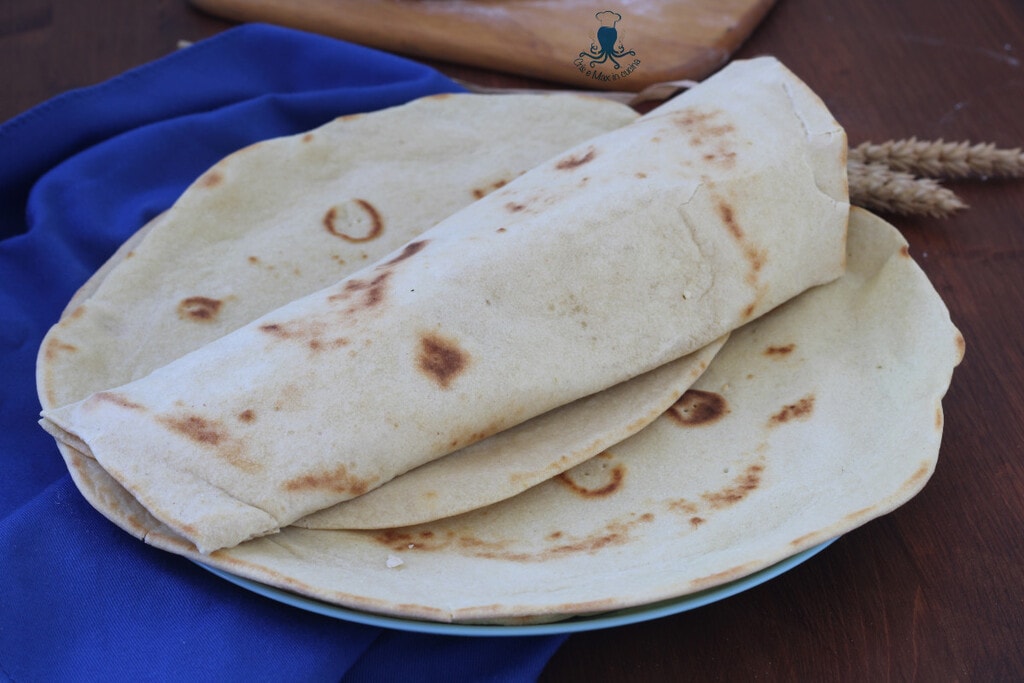The thin traditional Rimini flatbread is the most famous and widespread version of the Romagna flatbread, the one that has won over the taste buds of both tourists and locals along the entire Riviera. It is immediately recognizable because it is thin, soft, foldable, or rollable, ideal for filling and enjoying while strolling along the seafront or sitting in a typical flatbread shop.
Unlike the Forli flatbread, which is thicker and more rustic, the Rimini variant is designed to be quick and practical: its reduced thickness allows for quick cooking and a flexible texture, making it perfect for filling with fresh and light ingredients like squacquerone cheese, arugula, and prosciutto crudo, the iconic filling of Romagna.
The origins of the Rimini flatbread date back to the farming tradition, when it was prepared daily as a bread substitute. Over time, thanks to the spread of flatbread shops along the coast, it has become a true gastronomic icon, a symbol of Romagna hospitality. Even today, walking around Rimini, it’s impossible not to smell the aroma of freshly cooked flatbread on the testo, ready to be filled with cold cuts, cheeses, or more modern variations that follow culinary trends.
Preparing the Rimini flatbread at home means bringing to the table not only a simple and quick recipe but also a piece of history and identity of Romagna. Soft, elastic, and fragrant, it is the perfect choice for those who want to savor the authenticity of one of Italy’s most beloved dishes, versatile and suitable for all occasions, from informal dinners with friends to a tasty and light snack.

- Difficulty: Very easy
- Cost: Very economical
- Rest time: 20 Minutes
- Preparation time: 10 Minutes
- Portions: 6 flatbreads
- Cooking methods: Stovetop
- Cuisine: Italian
- Seasonality: All seasons
Ingredients for the thin traditional Rimini flatbread:
- 4 cups all-purpose flour
- 2.5 oz lard
- 1 cup warm water
- 2 tsp fine salt
- 1/2 tsp baking soda
Tools for the thin traditional Rimini flatbread:
- 1 Kneading board wood
- 1 Rolling pin wood
- 1 Bowl
- 1 Pan non-stick
Steps for preparing and cooking the thin traditional Rimini flatbread:
Pour the flour into a large bowl and place the softened lard in the center. Add the salt and baking soda, then start incorporating the water little by little, kneading with your hands. Work until you obtain a uniform and elastic dough. Form a ball, leave it in the bowl, and cover the bowl with plastic wrap or a cloth and let it rest for at least 20 minutes.
After the resting time, divide the dough into 6 equal parts and roll them out with the rolling pin to obtain thin discs, 2-3 mm thick, about 10 inches wide. Heat a non-stick pan, a cast iron griddle, or the traditional “Romagna testo” and cook the flatbreads one at a time, 1 minute per side, until the classic bubbles appear, which you will prick with a fork to obtain a uniform flatbread; the gas flame should be medium-high.
Continue cooking all the flatbreads, keep them warm by covering them with a cloth, then fill them according to your taste.
Recommended fillings:
The Rimini flatbread, being thin and elastic, folds easily in half or like a book: this is why it is the queen of Romagna street food, ideal for enjoying while strolling along the seafront or in a typical flatbread shop.
Squacquerone, arugula, and prosciutto crudo → the iconic filling of the Riviera.
Fresh cheeses (stracchino, crescenza) + raw vegetables.
Light cold cuts (bresaola, turkey, cooked ham).
Mozzarella and tomato (Caprese style).
Sweet fillings → Nutella or jam, as its thinness also lends itself to dessert versions.
FAQ (Questions and Answers)
How thick should the Rimini flatbread be?
About 2-3 mm: it should remain thin, soft, and easy to fold.
What are the most typical fillings?
The iconic filling is squacquerone, arugula, and prosciutto crudo, but it can also be filled with cold cuts, cheeses, and grilled vegetables.
Can I replace lard with oil?
Yes, but the texture will be less elastic and the flavor more delicate compared to the original recipe.
How do you store Rimini flatbread?
After cooking, it remains soft wrapped in a cloth. Alternatively, it can be frozen and reheated as needed.

